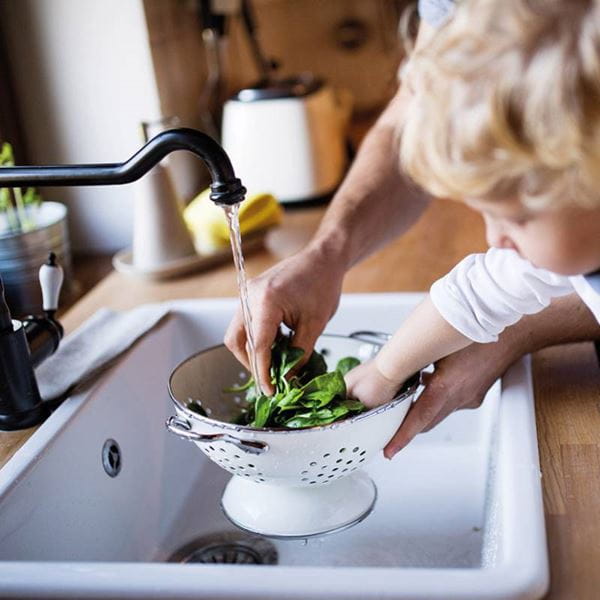Water quality in the home
What's here
Slime and staining
What causes slime and staining?
Bacteria and fungi present naturally in air, water and household dust can attach to damp surfaces and multiply to form a visible black slime or stain in various colours (black, red, pink). These growths are known as biofilms or ‘microbial slime’ and are most often visible in areas of the house that have a moist environment e.g. bathrooms and kitchens. If biofilms are not removed as soon as they form, they can grow into certain materials, such as tile grout and shower curtains, permanently marking them with black, pink or red stains.
Where do biofilms occur?
Biofilms can form on any surface that comes into contact with water such as:
- On the inside of cold water taps — sometimes they form grey/black jelly-like or slimy deposit that dangles from the spout of the tap
- Around the base of tap fittings
- In shower heads and on shower curtains
- On tiles in the bathroom/shower area
- In drains and plugholes
- On kitchen sink draining surfaces
- Within household appliances
Although these biofilms can appear very unpleasant they are generally harmless and do not pose a risk to health.
Top tips:
Unfortunately, there is nothing we can do to the drinking water supply to prevent the growth of biofilms within customers’ properties. However, there are a few ways you can prevent biofilm growth in your home:
- Routine cleaning with a mild bleach or sterilizing solution can remove any biofilm growths. Black slime associated with tap fittings can be removed by cleaning the inside of the tap or around the base of the tap with a small brush (e.g. an old toothbrush) dipped in a mild bleach or sterilizing solution. Removing any plastic inserts or detachable fittings and cleaning them regularly will also prevent biofilms from regrowing. The tap should be thoroughly flushed immediately afterwards. If growths are not removed on a regular basis they can grow into shower grouts, silicone sealants and shower curtains, staining them permanently.
- Increasing ventilation in warm damp rooms (such as bathrooms, kitchens and wet rooms) will prevent water standing on surfaces for too long which can promote biolfilm growth. Using a squeegee to remove excess water from shower screens and tiles is an effective method of preventing biofilm growth.
- Wiping surfaces regularly with a household cleaner will prevent biofilm growth by removing any left over products such as shampoo, soap, washing powder or hairspray. These products can act as food sources for bacteria and fungi.
- In-line filters and softeners can also be affected by biofilm growth so it is important that they are serviced according to the manufacturers' instructions. See our page on Water Hardness for more information about water softeners.
Water filters
We take enormous care to provide safe water to all our customers for drinking, cooking and washing. To make sure there are no harmful bacteria, water is disinfected with chlorine. Very small amounts of chlorine stay in the water as it leaves the treatment works to preserve the quality before it reaches your tap. Chlorine in drinking water isn’t harmful because we add such low levels.
Do I need a water filter?
No, because the water is treated to the highest standards. Some of us though are more sensitive to the taste of chlorine and using a water filter can reduce the taste. Filters are also used to reduce the hardness of the water. It’s purely down to personal choice.
There are two types of filters:
- An "in-line" filter, usually fitted under the kitchen sink by a plumber, or
- A jug filter
If you’re thinking of using a water filter for water hardness, make sure you read our factsheet ‘Water Hardness’.
Things to remember about water filters
Because filtering removes any remaining chlorine from the water, the points below are a useful guide to making sure you keep your water safe to use:
- Run your cold tap for a minute or two before using a jug filter
- Don’t let filtered water stand for any length of time in direct sunlight
- Keep your filtered water stored in the fridge and use it within 24 hours
- Wash your filter jug with hot soapy water on a regular basis — but not the filter itself
- Make sure you follow the manufacturer’s guidelines. Filters can become unhygienic if they’re not changed or used properly
- If you see tiny black particles after the water is filtered, this could be a sign that there is a fault and the filter may need to be replaced.
Lead pipes
There are strict regulations governing the maximum amount of lead allowed in drinking water. Up to the 1970s, lead was a widely used material for making water pipes and tanks and so can still be found in properties built before 1970 that have not been fully modernised. Lead solder was also used on internal pipework up to the 1980. Where lead is found in tap water, it usually comes from old lead pipework connecting the property to the water supply or in the internal plumbing of the property including lead solder. Water leaving water treatment works will contain little, if any lead. If you think you have lead pipes or solder, you can contact us to arrange a free water test from the cold kitchen tap to check the levels of lead in your water.
How do I know if I’ve got lead pipes in my house?
There are a few simple checks you can do to identify if there are any lead pipes in your property:
- Find where the water pipe runs into your property; this is normally at the internal stop tap which is usually under the kitchen sink.
- Check along as much of its length as possible.
- Unpainted lead pipes are dull grey in colour and soft.
- If you gently scrape the surface with a knife, you will see a shiny, silver, coloured metal beneath.
- Lead pipes often have swollen joints.
What can I do to reduce levels of lead in my tap water?
If you are concerned about the lead pipes or lead solder, you may wish to have your water tested for lead content. We offer free lead tests to customers on request. If you do find lead pipes in your property it is possible to reduce lead levels in the short term by following some simple precautions before using the water for drinking or cooking.
- Flush water that has been standing in pipes for a few hours such as overnight or if the house has been empty for the day. Run water from the cold tap used for drinking water until a washing up bowlful of water is collected. This water need not be wasted, for example you could collect it for watering your plants.
- Always use water from the cold water tap for drinking water or cooking. Hot water dissolves lead more quickly than cold water and is therefore more likely to contain greater amounts of lead. If hot water is needed for drinking water or cooking, water should be drawn from the cold water tap and heated. Use only thoroughly flushed water from the cold water tap for drinking and when making baby milk formula.
Where can I find more advice about lead?
Make sure you read our leaflet on ‘Lead in Drinking Water’.
Fish owners
Can I use tap water in my pond or aquarium?
Water quality standards are set to ensure that tap water is safe for humans to drink. At water treatment works, the pH of the water is adjusted in order to ensure the water is not corrosive to metallic pipework and chlorine is added to make it safe to drink. Fish do not naturally encounter soft alkaline water and chlorine is harmful to them, so drinking water from the tap requires conditioning before it is used for keeping fish or other aquatic organisms. However, as long as some basic rules are followed, tap water can be used in aquariums or ponds for keeping hardy species of fish.
The basic rules for fish keeping:
- Always use water from a mains-fed cold tap, do not use a tank supply.
- Allow the tap to run for a sufficient period to remove standing water from the pipework before filling a container.
- Some fish and particularly marine invertebrates are very sensitive to the metals taken up from domestic pipework like copper and zinc, which can accumulate overtime to problem levels in tanks or ponds.
- Never use water from a hot tap, or artificially softened water.
Temperature requirements
Tap water is generally much colder than the water in indoor aquariums and fish tanks, and can also be colder than pond water in summer. Fish are vulnerable to rapid temperature changes, they can go into shock which may be fatal. For heated aquariums, warm the water prior to addition by adding a little boiled water heated in a non-metallic container, or by using an aquarium heater to raise the temperature. Slowly adding a mist spray of water to top-up evaporation losses from ponds shouldn’t cause problems, provided, only small amounts are added on a daily basis.
Chlorine requirements
To make sure that tap water is safe to drink, we disinfect it using low concentration of chlorine. None of our water treatment works add chloramine to the water.
It is important to always remove chlorine from water before it is used for keeping fish. This should be done by adding the recommended amount of dechlorinator to water prior to it being added to a tank or pond.
Does mains water change once it’s added to a tank or pond?
Yes, fish waste, plant and algae growth, overfeeding and poor filtration, all produce toxic nitrogenous waste, and lower dissolved oxygen levels. Algae growth can result in rapid daily pH changes. If nitrogenous waste is allowed to accumulate this will cause distress to fish and they may die. Biological filters can be used to remove nitrogenous waste, but must be maintained to ensure they are effective. If you want to see the average quantity of nitrates in your water, please look at the most recent water quality zone report on our ‘In Your Area’ site.
Where can I find more information?
Make sure you read our leaflet on Fish Keeping
Moving House
How can I check my water quality?
If you have recently moved into a new property and want to check the hardness or water quality in the area, this information can be found on the ‘In Your Area’ section of our website.
My property has been vacant for some time, will this affect water quality?
If the property has been unoccupied for a while, we would recommend flushing the water through the system to remove any stagnant water from the pipework. After flushing, if you notice an unusual taste, odour, or appearance to the water, you can contact us for more advice.
Water searches
During a property purchase, conveyancers may conduct a water search on the property. This can involve looking at the most recent water quality zone report for the area where the property is located. It is important to remember that these zone reports summarise all the samples taken in each zone on an annual basis and are not property specific. You can check the latest water quality zone report for your area by putting your post code into the ‘In Your Area’ section of the website. For further advice or information, please contact us.

Water Supply
Information Sheets
Browse our leaflets around your water supply, including information on fluoride, iron, maganese and lead.

Water Health Partnership Lead factsheet
PDF, 294.6kB
There are strict regulations governing the maximum amount of lead allowed in drinking water.

